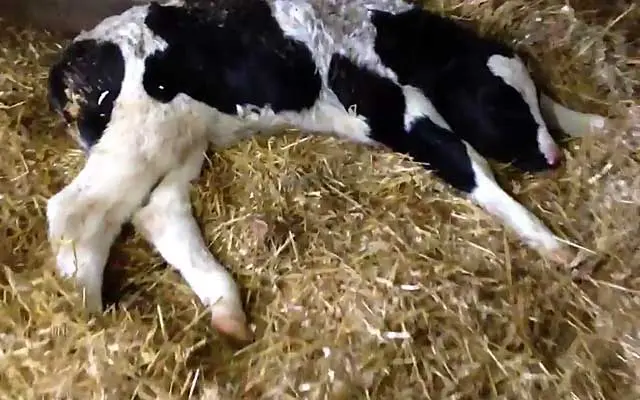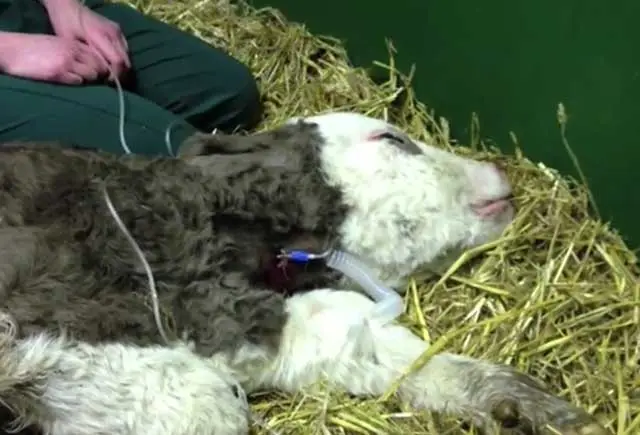Contents
Bronchopneumonia of calves is often encountered in veterinary medicine. The disease itself is not dangerous, but requires timely treatment. The neglected form of bovine bronchopneumonia leads to irreversible processes in the respiratory organs, which increases the mortality of young animals. It is possible to avoid such consequences.
What is bronchopneumonia
Bronchopneumonia of cattle is an inflammatory process in the bronchi and lungs of young animals, which is accompanied by the accumulation of catarrhal exudate in the lumens and cavities of the alveoli.
The disease is long, however, quickly spreads throughout the bronchial tree. Mostly young calves, whose age does not exceed 30-45 days, are affected.
Causes and risk factors
According to many scientists and researchers, bronchopneumonia in young cattle is a non-infectious disease. It occurs due to poor living conditions and poor feed. Among the main reasons, scientists named the following:
- unbalanced feeding of breeding stock;
- lack of retinol in feed for cattle;
- overheating or hypothermia of calves in the first months of life;
- keeping young animals in a poorly ventilated area where many microbes accumulate.
Incorrect selection of pairs and mating with close relatives leads to the appearance of weak young animals, which are susceptible to various diseases, including bronchopneumonia. Errors in feeding the broodstock of cattle are fraught with a deficiency of vitamin A, which should be present in large quantities in the milk of cows. Avitaminosis is dangerous for calves fed with this milk. In young animals, the protective functions of the body are reduced, bacteria and microbes easily penetrate the respiratory tract.
The calf housing should be dry and warm. Dampness, cold, stagnant air and drafts contribute to circulatory disorders, as a result, mucus, dust, bacteria, ammonia accumulate in the lungs, which leads to the rapid development of bronchopneumonia.
In addition to these factors, there are anatomical features of young cattle:
- narrow passage in the bronchi;
- short trachea in calves;
- a large accumulation of blood vessels on the mucous membrane of the respiratory tract;
- inelastic tissue of the alveoli.
The accumulation of all or several causes leads to the rapid onset and development of an inflammatory process in the respiratory tract of young cattle, which leads to bronchopneumonia.
clinical picture
It is difficult to recognize bronchopneumonia, since all organs of calves are involved in the process. At the beginning, changes occur in the nervous system of young animals, the protective functions of the body decrease. The amount of protein in the blood increases, stagnation occurs in the lungs and swelling of the bronchi. Such a microflora contributes to the development of microbes, the accumulation of toxins, an inflammatory process begins, necrosis of the tissues of the mucous membrane. The affected areas are poorly visible, become compacted. The calves begin to cough and snort.

With the development of bronchopneumonia in young cattle, ventilation of the lungs becomes difficult, gas exchange in them is disturbed, pressure decreases, the liver and kidneys do not work well, changes occur in the heart muscle. As a result, sick calves experience a fever, they suffer from shortness of breath, their coat looks untidy, most often young animals cannot rise to their feet.
If bovine bronchopneumonia is diagnosed in time and treatment is started, then in a week or 10 days the calves will improve. Otherwise, a secondary lesion, pleurisy or pericarditis occurs.
Bronchopneumonia in young cattle occurs in 3 stages:
- easy;
- acute;
- subacute or chronic.
The mild or initial form of the disease lasts 5-10 days. It starts with discomfort. The calves are lethargic, their appetite is reduced. On the 3rd day, the body temperature rises to 40-42°C, against which there is shortness of breath and shortness of breath. Serous mucus comes out of the nose, gradually it becomes purulent. A dry cough appears, which is replaced by a wet one. Heart sounds are muffled. In the blood of young cattle, typical changes occur that are characteristic of the inflammatory process.
The acute stage begins suddenly. Calves are clearly stunted, they have no appetite at all, they constantly cough. Body temperature rises slightly. The mucous membranes of the eyes are pale, serous mucus is discharged from the nose. Wheezing is heard in the lungs. The tissue at the sites of the lesion is compacted; during the examination, lesions up to 2 cm in diameter are visible. The lymph nodes are easily palpable. If the calf dies, then at the autopsy, edema of the upper respiratory tract can be detected, catarrhal exudate is released from the lesions.
Chronic or subacute stage of bovine bronchopneumonia lasts 20-30 days from the moment of injury. The course is undulating, exacerbations occur periodically. The appetite of young animals is poor, the cough is wet, the body temperature is normal in the morning, rising by 1,5 ° C in the evening. Shortness of breath increases, the general condition of the calves gradually worsens, diarrhea appears, signs of toxicosis and intoxication of the body. The areas of the lungs affected by bronchopneumonia are dough-like in consistency, fluid accumulates in them. An autopsy of a dead calf shows that the liver is enlarged, the gallbladder is full, and the heart muscle is dark in color.
Diagnostics
A number of procedures will help to make the correct diagnosis. First you need to pay attention to the general condition of the young cattle. The calves lie under the shoulder blades and in the knee crease, you can feel the lymph nodes, however, this does not cause inconvenience to the animal. The body temperature remains normal, the conjunctiva of the eyes is slightly swollen. The appetite of young animals with bronchopneumonia is weak, the act of chewing is reduced.
Pronounced changes in bronchopneumonia are noticeable on examination of the respiratory tract:
- shallow breathing;
- shortness of breath is present;
- clear mucus is discharged from the nose;
- a dry cough begins, gradually turning into a wet one;
- rales are heard in the lungs and bronchi.
Blood tests can confirm the diagnosis. During the study, it can be seen that the total number of red blood cells and hemoglobin are reduced, there is not enough carotene, phosphorus, calcium, and protein in the serum. All of this evidence proves that the diet of the calves was severely compromised, resulting in malnourishment and vulnerability.

In order to correctly diagnose, it is important to take into account the general condition of the young, data on the nutrition of the mother and the maintenance of the herd. In addition, it is important to pay attention to the place of walking and resting calves. General behavior, biochemical analysis of blood and x-rays together will give a complete picture.
The task of the veterinarian is to exclude infectious diseases and viral pneumonia in calves. Only then can the treatment of bronchopneumonia be started.
Therapies
Bronchopneumonia in young animals should be treated comprehensively, depending on the severity of the course of the disease. It is best to collect all the animals in a single group. In order for the treatment to proceed well and quickly, as well as to give a positive result, it is important to provide the calves with good nutrition and create suitable conditions for their maintenance.
With properly planned treatment, the initial stage of bovine bronchopneumonia, its acute form, can be stopped. However, it is impossible to get rid of chronic bronchopneumonia. The process can be suspended, to alleviate the condition of the animal, but nothing more.
The complex of medical procedures includes the following:
- antimicrobial therapy;
- symptomatic;
- replacement.
For the treatment of bronchopneumonia in cattle, broad-spectrum antibiotics are used, if necessary, together with arsenic preparations. Additionally, vitamins, mineral complexes and agents are prescribed that will help relieve the main symptoms of the disease.
In modern veterinary medicine, aerosol agents are used to treat bovine bronchopneumonia. This is justified by the fact that the smallest particles of the drug enter directly into the lungs, bypassing the liver of calves. They are better absorbed into the blood and act on the affected areas within a few minutes.
Antimicrobials are administered intramuscularly or intratracheally, which is more effective. Use of penicillin or tetracycline is allowed. Bred them in accordance with the instructions.
To combat coughing and facilitate pulmonary breathing in calves, expectorants are used in combination with inhalations with sodium chloride vapors. Vitamin therapy is of great importance, as it reduces the occurrence of side effects from taking antibiotics.
The introduction of immunoglobulin serum will help restore the immunity of young animals. The injection is made 2 times with an interval of 48 hours.
Researchers and leading veterinarians in this field have proven that the most effective recovery of young cattle with bronchopneumonia occurs under the influence of hemotherapy. The blood of the animal is subjected to purification, after which it is reintroduced into healthy tissues. Doses are determined by the attending veterinarian, taking into account the patient’s condition. In the acute course of bronchopneumonia, a single administration of 125-150 ml of serum is allowed. The number of injections is determined individually, up to 5 injections are allowed with an interval between them of 2 to 4 days. However, only the first 2 injections give the effect.
If there is no visible improvement, then the introduction should be stopped. You can judge the success of therapy in the case of:
- lowering the temperature to normal levels;
- reduction of the inflammatory process;
- disappearance of edema.
In some cases, to achieve a positive result, they use artificial heating of young animals with special lamps, and rub the chest.
Forecast
Timely treatment of calves with bronchopneumonia is economically justified. With a properly selected course, after 7-10 days the animal will feel better. It won’t be long before full recovery.
The advanced form of the disease and its chronic stage are difficult to treat. As a rule, such calves are culled.
Preventive measures
All measures to prevent bronchopneumonia should be aimed at observing economic and sanitary standards. Premises intended for keeping young cattle must comply with the standards. Air humidity is maintained at 70%, ammonia values should not exceed 5 mg/m5, temperature differences should not exceed XNUMX°C.
In addition, nutrition of calves in the first days of life is important. The only food for the young is colostrum and mother’s milk. In the prevention of bronchopneumonia, walks of young cattle in the fresh air are important. However, overheating of animals should be avoided. In hot weather, they should be under a canopy.
In the premises for young animals, wet cleaning is carried out daily in compliance with all sanitary and technical standards. Good results are obtained by spraying cattle with disinfectants. Feed is distributed in the form of a wet mash to reduce dust in the air. Mandatory is the introduction of vitamins, premixes and other drugs aimed at increasing the protective functions of the body.
Conclusion
Bronchopneumonia of calves is a dangerous disease of cattle, which can be successfully treated. However, it needs to be diagnosed and treated early. The main causes of bronchopneumonia are poor conditions for keeping young animals and insufficiently balanced feed.









